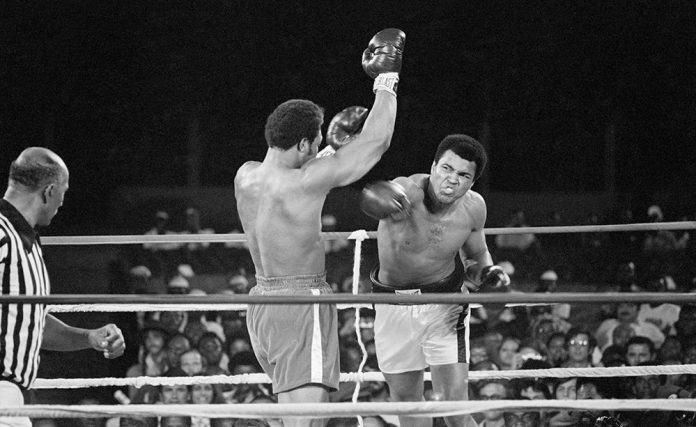Muhammad Ali (r) punches George Foreman (c) during their world heavyweight title boxing match in 1974, as a referee looks on.
On October 30, 1974, the world stood still as two of the greatest heavyweights to walk this planet met in the ultimate crossroads.
Rivers of ink have flown to describe this battle, and it has been described a million times in a million ways. Muhammad Ali, the former champion trying to return to his former glory after being stripped of his belt for refusing to go to the Vietnam War, against George Foreman, the young undefeated former Olympic knockout artist, and so many more storylines. The endless retelling of this story of fall and eternal redemption has been an essential chapter in sports folklore for half a century, and very few stones have been left unturned in this endeavor.
Instead of trying to rehash the entire epic again, I’ve decided to break down the highlights of this amazing championship clash into a handful of items that make Ali-Foreman one of the most memorable sporting events of all time.
How big was the Rumble in the Jungle? Let us do the countdown for you.
A king is born: Fresh out of prison, tired of the numbers cruncher, always looking for a new angle, and already a world-class practitioner of the “fake-it-to-you-make-it” American way of doing business. Don King was all that and more. Already involved in the concert production business, King asked singer Lloyd Price to set him up with Muhammad Ali under the pretense of producing a charity event in an attempt to sink his teeth into the fight game.
Now, I hope this might be the part where we say “the rest is history,” but King’s history making runs as a boxing promoter was still so much in its infancy that no one could predict what was coming.
King was determined to kick the door on the way in and made his first big attempt at boxing a big one. After both Foreman and Ali promised a one-time multi-million dollar purse for a fight that would bring two of the baddest and meanest African-American fighters of all time back to the motherland in an unforgettable night with the world as their heard, King tried to get the financing to fulfill his promise until he found it deep in the pockets of Zaire (present-day Congo) dictator Mobutu Sese Seko.
And yes, the rest is history.

Muhammad Ali hangs out with Congolese dictator Joseph Mobutu two days before upsetting George Foreman.
The buildup: Somber, brooding, unable to elicit or even display a fraction of the smiles he would be known for years later during his run as a circus tent preacher, sit-comer and electric barbecue salesman, was George Foreman the antithesis of the brash and tough Ali, who was already showing decline in his boxing abilities but whose promotional game was in its absolute prime. When Foreman stepped off the plane in Zaire with his two German shepherds (the same dogs used by the Belgians during the brutal colonization of the country) and Ali stood on top of the steps of his own plane waving to the raucous crowd on the tarmac, the winner of the entire pre-fight competition was already clear.
And then there was a catchphrase…
They are still alive: We’ll never know who started it. But knowing Ali as the master of deception and self-promotion that he was, it was probably him. If this was indeed a spontaneous chant that grew in scope and loudness as the pre-fight build-up progressed, then so be it, and my apologies to anyone involved for thinking otherwise. But my gut tells me Ali came up with the idea, asked someone to translate it, started the chant with his fist in the air when he was surrounded by more than four people and didn’t stop until everyone around him shouted that two or didn’t have three words from the top of their lungs. And it is now among us to stay. Forever.
And, yes, that means “Ali … kill him!” If you didn’t already know.
The concert that never was: James Brown, Celia Cruz and the Fania All Stars, South African icon Miriam Makeba, The Spinners, The Crusaders, Bill Withers, BB King, Manu Dibango and many others. Instead of a long undercard full of fights that no one wanted to see, the event was designed to kick off with a three-night music festival featuring the biggest artists available in the vast African diaspora across all continents and languages to create the tapestry which would serve as the backdrop for the triumphant arrival of the greatest prize of all sports to the land of their forefathers. And it happened, but not as intended. When George Foreman suffered a cut during sparring and the fight was postponed until October 30, the artists who had already landed in Zaire finally played the concert that was later depicted in a separate documentary called “Soul Power”.

Ali presented The Ring Magazine Championship belt after dethroning Foreman. Photo from The Ring archive
The rope-a-baptism: Mountains have been there to be climbed since the beginning of time. But they only come into existence after someone mentions them. Only then do they become a challenge to be tackled or imitated. The idea of a fighter leaning back on the ropes in a guard taking punches or dodging and waiting for his enemy to tire before launching a counteroffensive has probably been around forever. But just like the dinosaurs and Mount Everest and the American continent, it didn’t enter the history books until someone slapped a name on it. Ali did, and it now belongs to him. Everyone just follows in his footsteps.
The timing and the weather: Day and night, come rain or shine. These seem to be the common options according to both the science of meteorology and the great American songbook. The Rumble in the Jungle covered all four of them. Yes. The fight started promptly at 4am in the morning to be broadcast in prime time in the US, when it was still dark in the outdoor stadium where the clash took place. As the battle progressed, the sun rose in a magnificent African dawn as poetic as the outcome of the battle. And just as his rays hit the ring in time for the post-fight celebration, some clouds gathered and found a way to join in the festivities by conjuring a brief but abundant downpour on the stadium.
The knockout blow: After eight rounds of wearing Foreman down and frustrated, Ali moved in for the kill. He’s already either landed or practiced that ropes counter to catch Foreman coming in and then counterattack by spinning on his heels. But this time it was particularly effective. The punching sequence has been described and repeated to exhaustion, but it is the swirling punch-drunk dance Foreman did as he went down to the canvas that has lived on in the memory of boxing fans worldwide. Foreman’s blank stare as he spins and falls as if trying to find a soft spot to land remains one of the ultimate knockout highlights of all time.
The reach: American soldiers fighting in the Vietnam War are said to have asked for a temporary truce to watch the Ali-Frazier I fight back in 1971. For poetic reasons, it would have been great if they also made their request for this to repeat battle. The Rumble that rumbled the war into another jungle, perhaps. It probably didn’t happen, but it doesn’t matter. As many as a billion people are estimated to have watched the fight live, in what at the time became the most watched live television show of all time.

Ali completes George Foreman in Zaire. (Photo by Tony Triolo/Sports Illustrated via Getty Images)
The inspiration: A documentary called “When we were kings” earned an Oscar after being compiled and edited with archival footage some 20 years after the battle. Some of the articles written about these battles have helped their authors earn Pulitzers and other awards. Author Norman Mailer wrote one of the most enduring masterpieces of boxing literature in his essential work called “The Fight,” one of only a handful of books devoted entirely to a single fight. Even Hunter Thompson’s story of how he failed to deliver a story about the fight to Rolling Stone magazine by the deadline became part of the fight’s long list of stories that eventually took on a life of their own. got
The legacy: From the name to the “bomayé” catchphrase to the referee shirt in black and white stripes, every aspect of this fight became part of popular culture and stayed there for a long time. Almost every feature that made this fight unique has been repeated, reused, plagiarized, and re-ignited in every possible way. From the unique location, to the months-long hyperbolic build-up, to the “creative sources of funding” and the use of sport as a way to temporarily whitewash a regime’s disgraceful human rights record and much more, the Rumble in the Jungle is a brand in itself, a name that needs no quotation marks or requires no introduction.
Everyone suspected they were witnessing history in the presence of Ali’s best moments, but this one was special even by those standards. With his glove extended towards the press row and his mouth soft and his eyes wide open, Ali made it his business to shout “I told you so!!” to whoever would believe it, whether it was after his first title fight against Sonny Liston or after his clash with Foreman or whenever he was given the chance.
We should have believed him.
Fifty years after the fact, we really have no choice.
Diego M. Morilla has written for The Ring since 2013. He has also written for HBO.com, ESPN.com and many other magazines, websites, newspapers and outlets since 1993. He is a full member of the Boxing Writers Association of America and a voter for the International Boxing Hall of Fame. He has won two first-place awards in the BWAA’s annual writing contest, and he is the moderator of The Ring’s Women’s Ratings Panel. He served as copy editor for the second era of The Ring en Español (2018-2020) and is currently a writer and editor for RingTV.com.



